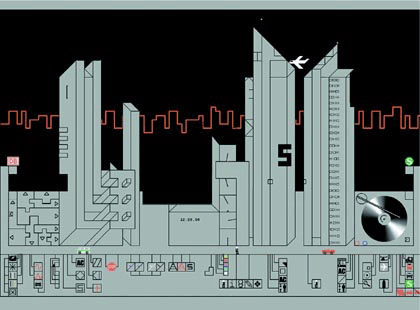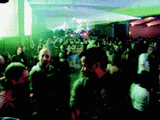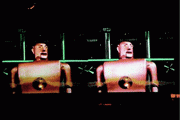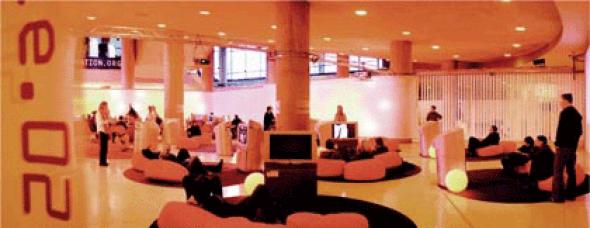1: THE CONFERENCE GAME
With a ludic theme and international roster, Berlin’s Transmediale festival played a global game. As visitor to and participant in the event, artist Bea Gibson found her close-up view of the proceedings left her more enervated than enthused
Following on from the latest edition of Ars Electronica, this year’s Transmediale centred on the theme ‘Play Global!’ Located, for the second time, in Berlin’s Haus Der Kulturen (see Julia Schneider, Mute 23), the festival aimed at providing a week-long forum for the recent but ongoing attempts to address cultural and artistic reactions to the problems of global connectivity, from migration politics, to issues of representation, to cultural imperialism. With Bush and Blair’s antics as the soundtrack in the background the organisers couldn’t have chosen a timelier theme.
Play Global, the eponymous conference of the festival dealt with artistic strategies for the global game, presenting a selection of artistic projects and ideas in which the utopias and dystopias of the globalisation scenario were played out. Coco Fusco’s video work, Dolores 10 – 20 hrs is a piece that simulates the surveillance camera gaze, exploring gender, the body and power in the context of Mexican migrant workers (see Gabriela Salgado, Metamute.com, 9.12.2001). The piece looks at our personal and political engagement – or perhaps disengagement – with feminist labour issues in the context of globalisation. Based on the true story of a migrant worker in Mexico who was falsely accused of attempting to form a union and subsequently dismissed after twelve hours of being of locked alone in a room without access to food water or toilets, the work depicts what might have happened had a surveillance camera been in place, making visible an event that had been made invisible by corporate interests while simultaneously commenting on our willingness to watch and inability to act.
Marko Peljhan presented his recent research on the political and military structures of telecommunications systems, reflecting upon developments in the area and outlining his collaborative attempts to develop bilateral strategies for sustainable growth and development. Peljhan believes that despite the power of global dynamics and the uneven distribution of knowledge, telecommunications are a very potent vehicle for change. There is an urgent need, he argues, to liberate communication systems from blind, solely capital based interests and use. Peljhan’s projects, on this basis, are tactical devices which seek to liberate telecommunications from their commodity status while simultaneously pointing to the very material consequences of this seemingly immaterial field.
Heidrun Holzfeind, an Austrian video artist living in New York, showed her video work on various migrant and diasporic communities. Stylistically, the works blur the boundaries between documentary, music video and interview, producing an engaging visual synthesis. Holzfeind interviews young teenage migrants, asking each interviewee to choose the final music for the piece, while focusing the camera primarily on body movement and gesture. The interviews are comprised of informal conversation between Holzfeind and her subjects and we hear much about the youngsters’ aspirations, from their careers, to their love lives, to the symbolic banality of their trainer collections.
My own project, Human Capital Software Solutions, produced in collaboration with Sejal Chad and Adrian Ward, was also presented here. Human Capital is a piece of text-sound composition software packaged as a training tool for call centre workers in India. Part tool part satire, the software parodies the ‘communication philosophy’ of the burgeoning remote processing industry, while at the same time allowing for processes which might frustrate or subvert the mechanisms of modelisation and homogeneity through its potential for acts of composition.
Home Electronics, a second conference, organised by Club Transmediale (the festival’s parallel sound art symposium), attempted to analyse the local importance of electronic music production. The conference was essentially about whether the intrinsic nature of electronic music – its potential for digital sound processing, its instruments, its production, distribution and reception structure – renders it devoid of local influence as a medium. Including presentations by David Toop, whose talk was conceptually the most relevant, Alain Mongeau, director of the Mutek festival of music and new technology in Canada, and hacktivist Fran Illich, the panel never really got off the ground. Despite a potentially interesting premise, Home Electronics, rather like Play Global, unfortunately disintegrated into disparate and seemingly unconnected recitals by the individual panelists.
 >> Akwido: Stadt Sound Station
>> Akwido: Stadt Sound Station
The better of the festival’s conferences was Social Software presented by De Waag. An outline of the organisation, its aims and founding principles was presented, followed by a selection of recent work reflecting De Waag’s engagement with creative software in areas such as education, work, arts and culture. Graham Harwood’s software tool, Nine, is a database of maps for use by residents of troubled neighbourhoods which enables them to relate their various experiences though a culture of cartography. Story Table is a piece of software developed by De Waag that is installed in ‘tables with intuitive interfaces’ at the Twiske Home for the elderly. Story Table allows the elderly residents of Twiske to access a database archiving audio visual clips from the ‘good old days’ as well as upload their own memories. Related presentations were given by associates of De Waag, such as Florian Cramer, and were followed by a pertinent and conceptually coherent debate on the nature and potential of software as a culturally and socially codified instrument. In the course of Social Software, the De Waag representatives came down off the stage and rearranged the chairs, prompting a larger more inclusive debate, and resulting in one of the only decent participatory and productive exchanges of the event. This was telling. As mentioned above, a recurrent feature of Transmediale 2003 was the lack of productive dialogue both between conference participants themselves and with audience members. This touches really on the crux of the issue in the larger context of the conference and its bizarre or perhaps simply passive adoption as the ‘ideal format’ for the presentation and dissemination of new media works. While Transmediale undoubtedly provided an exciting selection of works to browse and consume, and, to be fair, its performances, workshops and external events were legion, it failed miserably in terms of being a critical meeting point wherein strategies can be democratically and productively addressed, revised, reformulated and so on.

 >> People Like Us, visuals. Photo Magda Myjak
>> People Like Us, visuals. Photo Magda Myjak
This is hardly surprising. As noted at practically every new media festival, the conference approach is outmoded. It focuses on productivity rather than process and fails to capitalise on the potential for locating works within a larger, connective discourse. Despite organisers’ intentions, the questions pitted as the premise of conferences are rarely (productively) broached. Given the long-standing frustration with the conference format, the phenomenon of festival fatigue, and years of complaints vis-a-vis badly engineered sociality, one wonders why the hell we are still sitting bored to tears in auditoriums. The conference formula is exclusive, celebrity orientated, and eliminates any kind of spontaneity. Furthermore, and perhaps ironically in the context of Play Global, the rigid structures of panel, conference, auditorium and artist-presenting-a-‘piece’ constituted yet another hegemonic practice paradigm. This centralised power essentially controls the definition and the boundaries of the ‘discussion’ and disallows productive exchange, more often that not prompting understandable audience suspicion of the artists’ motive, plane ticket, entrance fee and moral standing in general, rather than opening up exploration of the content of projects in their own right.
The importance of ‘meetspace’ has been discussed elsewhere also. It is critical. We need ‘breast to breast’ contact. But to explore the social, political and economic issues that new media art throws up we need first to consider the need to create alternative contexts for art activity and representation. One would imagine that, given the nature of networked production and the long history of conference critique, it would to be the ideal place to start not only re-imagining but manifesting these alternative contexts. Apparently not. At the moment it seems a choice between the shatteringly boring celebrity conference or the exclusive ‘temporary’ lab. We desperately need to find a middle ground, an inclusive space where the public and a diverse array of practitioners can meet on equal terms. We need a paradigm wherein the one-to-many model of the speaker addressing the audience is done away with and wherein works can be presented to the public, discussed and understood beyond the narrow and contextually problematic category of art work. At the same time we need also to counter the ‘heroic’ and exclusive lab, where the same names sit next to each other year after year, without a public, further ghettoising an increasingly incestuous and insular network.
 >> Till Passow, Howrah, Howrah
>> Till Passow, Howrah, Howrah
A further complaint I had with Transmediale – a festival ostensibly addressing strategies for the global game – was its stark and utter lack of globality. While presentations were in both English and German and the programme reflected an earnest although perhaps unsuccessful attempt at global inclusivity, the festival ultimately had an unflinching Eurocentrism about it. Given the wide scope of autonomous self-organising spaces and new strategies that are being designed by artists and theorists alike in South Asia, Asia Pacific and South America, for example, and the richness they would have added to the debate, their presence was greatly missed. While not wanting to suggest that the solution lies simply in numerically egalitarian and therefore purely representational answers, and further that these are problems that have not already been mulled over at great length by curators and artists alike, it did strike me as particularly strange that, at the very least, more artists outside the western hemisphere had not been sought out and invited to attend. The problem is deep rooted and admittedly not solved by simply inviting non-Europeans. We have also to think about use of language, space and scheduling very carefully if we are to attempt a properly diverse reflection of all the different locales that make up the global.
In sum, organisers need to be less Eurocentric, get off the internet, seek out flesh connections beyond the insular Euro network and actively tackle and implement longstanding critiques. Increasingly isolated and increasingly ghettoised, we need less self-historicisation, more inclusivity, and radically reworked ‘global’ paradigms that are actually implemented rather than simply theorised.
Transmediale 03: Play Global! 1–5 February 2003[http://www.transmediale.de]
Bea Gibson <bea AT nungu.com> is a new media artist and researcher based in Mumbai and London. Her work has featured in exhibitions and festivals in New York, London, Sao Paolo and Berlin. She founded the website [http://www.nungu.com] in 2001, and helped develop [http://www.gaisecurity.com] in collaboration with Sheifali Chad and Vivek Sasikumar
Mute Books Orders
For Mute Books distribution contact Anagram Books
contact@anagrambooks.com
For online purchases visit anagrambooks.com








